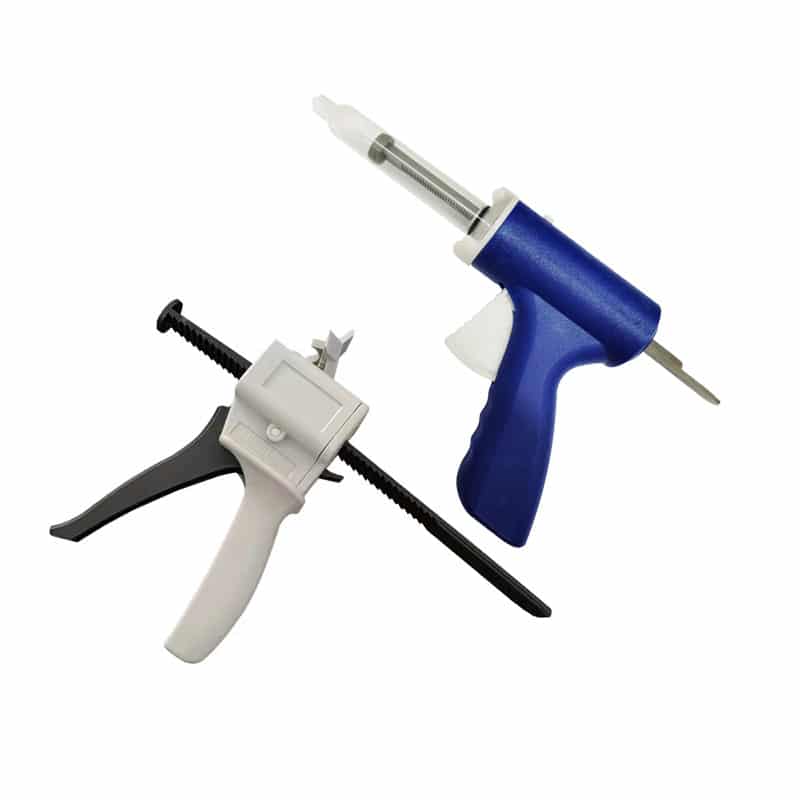The epoxy gun, also known as a dispensing gun or applicator gun, is a tool used to dispense epoxy resin and hardener from cartridges. It consists of several key components:

Frame: The frame of the epoxy gun provides stability and support for the other components. It is typically made of metal or durable plastic.
Trigger Mechanism: The trigger mechanism controls the flow of epoxy from the cartridge. Squeezing the trigger releases the epoxy, while releasing the trigger stops the flow.
Cartridge Holder: The cartridge holder is where the epoxy cartridge is inserted. It securely holds the cartridge in place during dispensing.
Plunger: The plunger is a rod that is inserted into the epoxy cartridge. When the trigger is squeezed, the plunger moves forward, pushing the epoxy out of the cartridge.
Dispensing Nozzle: The dispensing nozzle is attached to the end of the epoxy gun. It controls the shape and size of the epoxy bead as it is dispensed.
Using an epoxy gun is relatively straightforward. First, insert the epoxy cartridge into the cartridge holder and make sure it is securely in place. Next, remove the cap from the cartridge and attach the dispensing nozzle to the cartridge.
Before dispensing any epoxy, it’s important to prime the gun. To do this, squeeze the trigger several times until epoxy begins to flow smoothly from the nozzle. This helps to ensure that the epoxy is properly mixed and that any air bubbles are removed.
When dispensing epoxy, it’s important to maintain a consistent pressure on the trigger to achieve an even flow. If the epoxy gun becomes clogged, it can be cleared by removing the nozzle and cleaning it with a solvent.
Choosing the Right Epoxy Gun
Choosing the right epoxy gun is crucial for achieving the best results in your epoxy projects. Here are some key factors to consider when selecting an epoxy gun:
Size and Type: Epoxy guns come in various sizes and types to accommodate different cartridge sizes and dispensing needs. Make sure to choose a gun that is compatible with the size and type of cartridges you will be using.
Manual vs. Pneumatic: Epoxy guns can be either manual or pneumatic (air-powered). Manual guns are more affordable and suitable for small-scale projects, while pneumatic guns are more expensive but offer faster and more consistent dispensing for larger projects.
Dispensing Rate: Consider the dispensing rate of the epoxy gun, which is usually measured in ounces per minute. Choose a gun with a dispensing rate that matches your project requirements to avoid wastage or delays.
Durability: Look for an epoxy gun made from durable materials, such as metal or high-quality plastic, to ensure that it can withstand regular use and last for a long time.
Features: Some epoxy guns come with additional features, such as adjustable dispensing pressure, built-in cartridge cutters, and ergonomic grips. Consider these features based on your comfort and convenience preferences.
Brand and Reviews: Research different brands of epoxy guns and read reviews from other users to get an idea of the quality and performance of each gun. Choose a reputable brand with positive reviews for the best results.
Compatibility with Accessories: If you plan to use accessories such as mixing nozzles or extension tips, make sure that the epoxy gun is compatible with these accessories to ensure smooth operation.
Preparation Before Use
Proper preparation of your epoxy gun is essential for ensuring smooth and efficient operation. Follow these steps before using your epoxy gun:
Cleaning: Before loading the epoxy cartridge into the gun, make sure to clean the gun thoroughly to remove any dust, debris, or residue from previous use. Use a clean cloth or paper towel to wipe down the gun and remove any buildup.
Priming: Priming the epoxy gun is important to ensure that the epoxy resin and hardener are properly mixed before dispensing. To prime the gun, squeeze the trigger several times until both components are flowing evenly from the nozzle.
Loading the Cartridge: Insert the epoxy cartridge into the cartridge holder of the gun. Make sure it is securely in place and that the plunger is aligned with the back of the cartridge.
Cutting the Nozzle: If the cartridge does not have a pre-cut nozzle, use a cartridge cutter or utility knife to cut the tip of the nozzle at a 45-degree angle. The size of the nozzle opening will determine the bead size of the dispensed epoxy.
Removing Air Bubbles: Before dispensing epoxy onto your project, it’s important to remove any air bubbles that may have formed in the cartridge. To do this, hold the gun upright and gently tap the cartridge to help the bubbles rise to the top. Then, squeeze the trigger slowly to expel the air bubbles from the nozzle.
Testing: Before starting your project, perform a test dispensing on a scrap piece of material to ensure that the epoxy is flowing evenly and that the bead size is correct. Adjust the dispensing pressure if necessary.
Mixing Ratios
The mixing ratio of epoxy resin and hardener is critical for achieving proper curing and optimal performance of your epoxy projects. Here’s why it’s important and how to get it right:
Importance of Mixing Ratios: Epoxy resin and hardener must be mixed in the correct ratio as specified by the manufacturer. Deviating from the recommended ratio can result in improper curing, leading to weak bonds, poor adhesion, or incomplete hardening.
Consistency is Key: Mixing epoxy resin and hardener in the correct ratio ensures that the chemical reaction between the two components occurs as intended. This reaction is what gives epoxy its strength and durability.
Follow Manufacturer’s Instructions: Always refer to the manufacturer’s instructions for the correct mixing ratio for your epoxy product. The ratio is usually given by volume (e.g., 2:1 resin to hardener) or by weight (e.g., 100 parts resin to 50 parts hardener).
Measuring Tools: Use accurate measuring tools, such as graduated mixing cups or scales, to measure the resin and hardener. Ensure that the measurements are precise to avoid any issues with curing.
Mixing Process: Combine the resin and hardener in a clean container and mix them thoroughly. Use a stir stick or a mixing paddle attached to a drill to ensure that the components are evenly mixed. Scrape the sides and bottom of the container to incorporate any unmixed material.
Time and Temperature: The curing time and temperature of epoxy resin can affect its viscosity and working time. Follow the manufacturer’s guidelines for the optimal temperature range for mixing and curing the epoxy.
Small Batches: It’s best to mix epoxy in small batches to ensure that you can use it before it begins to cure. Avoid mixing more epoxy than you can use within the pot life (working time) specified by the manufacturer.
Application Techniques
Proper application of epoxy using an epoxy gun is crucial for achieving the desired results in your projects. Here are some tips for applying epoxy effectively:
Surface Preparation: Before applying epoxy, ensure that the surface is clean, dry, and free of any contaminants such as dust, dirt, or grease. Proper surface preparation is essential for optimal adhesion.
Masking: Use masking tape to protect areas that you do not want to be covered in epoxy. This will help you achieve clean, professional-looking results.
Mixing: Mix the epoxy resin and hardener thoroughly according to the manufacturer’s instructions. Ensure that the components are fully blended to avoid issues with curing.
Consistent Flow: When dispensing epoxy with the gun, maintain a consistent flow by applying steady pressure to the trigger. This will help you achieve an even application.
Layering: For thicker applications, apply the epoxy in layers rather than all at once. This will help prevent sagging and ensure that each layer cures properly.
Working Time: Be mindful of the working time (pot life) of the epoxy, as it will begin to cure once mixed. Work efficiently to avoid running out of working time.
Tool Cleanup: Clean the dispensing nozzle and any tools used for application immediately after use. Epoxy can harden quickly, so it’s important to clean up promptly.
Curing Time: Allow the epoxy to cure according to the manufacturer’s instructions before handling or applying additional coats. Curing times can vary depending on the temperature and humidity of the environment.
Safety Precautions: Always wear appropriate personal protective equipment, such as gloves and goggles, when working with epoxy to protect yourself from skin contact and eye injuries.
Cleaning and Maintenance
Proper cleaning and maintenance of your epoxy gun are essential for ensuring its longevity and optimal performance. Here are some tips to keep your epoxy gun in good condition:
Immediate Cleaning: Clean the epoxy gun immediately after use to prevent the epoxy from hardening inside the gun. Use a solvent recommended by the manufacturer to dissolve and remove any hardened epoxy.
Disassembly: If possible, disassemble the gun for thorough cleaning. Remove the plunger, cartridge holder, and any other removable parts to clean them individually.
Cleaning the Nozzle: Use a small brush or pipe cleaner to clean the dispensing nozzle. Ensure that all residue is removed to prevent clogging.
Solvent Flush: If the gun is heavily contaminated with epoxy, you may need to flush it with a solvent. Follow the manufacturer’s instructions for the proper solvent and procedure.
Regular Maintenance: Regularly inspect the gun for any signs of wear or damage. Replace any worn or damaged parts promptly to prevent further issues.
Storage: Store the epoxy gun in a clean, dry place when not in use. Avoid storing it near heat sources or in direct sunlight, as this can cause the epoxy to cure prematurely.
Greasing Moving Parts: Apply a small amount of lubricant to moving parts, such as the trigger mechanism, to keep them operating smoothly.
Avoiding Contamination: To prevent contamination of your epoxy, use dedicated tools and containers for mixing and applying epoxy. Do not use tools that have been used for other materials.
roubleshooting
Despite your best efforts, issues may arise when using an epoxy gun. Here are some common problems and their solutions:
Clogging: If the epoxy gun becomes clogged, remove the nozzle and clean it thoroughly with a solvent. Check for any hardened epoxy inside the gun and clean it out if necessary.
Uneven Dispensing: If the epoxy is not dispensing evenly, check for air bubbles in the cartridge and nozzle. Tap the cartridge to release any trapped air and ensure that the nozzle is clean and free of obstructions.
Leaking: If the epoxy gun is leaking, check that the cartridge is inserted correctly and that the plunger is properly aligned. Tighten any loose fittings or seals.
Hardened Epoxy: If epoxy hardens inside the gun, disassemble the gun and clean it thoroughly with a solvent. Replace any damaged or worn parts.
Poor Adhesion: If the epoxy is not adhering properly, ensure that the surface was properly prepared before application. Reapply the epoxy if necessary, following proper application techniques.
Stuck Plunger: If the plunger becomes stuck, disassemble the gun and clean the plunger and cartridge holder. Apply a small amount of lubricant to the plunger to help it move smoothly.
Low Flow Rate: If the flow rate of the epoxy is low, check for any obstructions in the nozzle or cartridge. Replace the nozzle if it is damaged or worn.
Inconsistent Mixing: If the epoxy is not curing properly, ensure that the resin and hardener were mixed in the correct ratio and that they were thoroughly blended. Reapply the epoxy if necessary.
